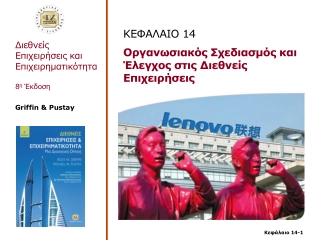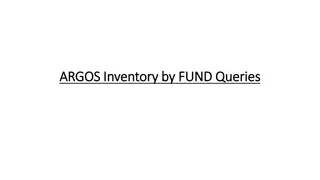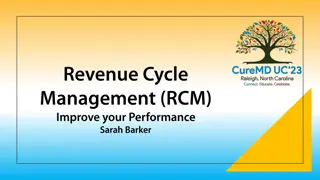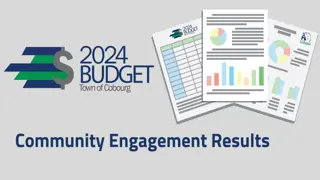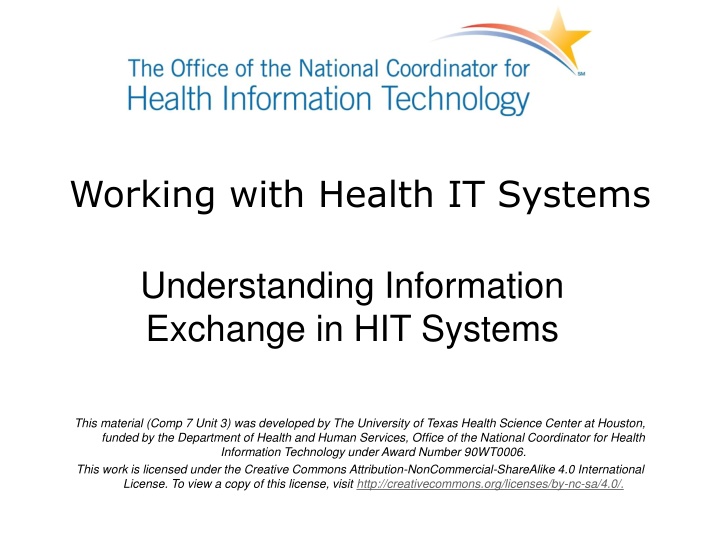
Understanding Information Exchange in Health IT Systems
Learn about the importance of information exchange in Health IT systems, the entities involved, the need for standards, and current efforts to facilitate health information exchange. Explore different types of information exchange and the incentives for meaningful use in HIT systems.
Download Presentation

Please find below an Image/Link to download the presentation.
The content on the website is provided AS IS for your information and personal use only. It may not be sold, licensed, or shared on other websites without obtaining consent from the author. If you encounter any issues during the download, it is possible that the publisher has removed the file from their server.
You are allowed to download the files provided on this website for personal or commercial use, subject to the condition that they are used lawfully. All files are the property of their respective owners.
The content on the website is provided AS IS for your information and personal use only. It may not be sold, licensed, or shared on other websites without obtaining consent from the author.
E N D
Presentation Transcript
Working with Health IT Systems Understanding Information Exchange in HIT Systems This material (Comp 7 Unit 3) was developed by The University of Texas Health Science Center at Houston, funded by the Department of Health and Human Services, Office of the National Coordinator for Health Information Technology under Award Number 90WT0006. This work is licensed under the Creative Commons Attribution-NonCommercial-ShareAlike 4.0 International License. To view a copy of this license, visit http://creativecommons.org/licenses/by-nc-sa/4.0/.
Understanding Information Exchange in HIT Systems Learning Objectives Identify entities that are commonly involved in HIT system data exchange. Explain the need for standards and why they exist. Define and differentiate between vocabulary, content exchange, and privacy and security standards. Compare current efforts to facilitate health information exchange between providers, communities, regions, and nation (NHIN, HIEs, NHIN Direct). 2
Types of Information Exchange Exchange of information between systems used by a single health care organization Exchange of information between HIT systems of two or more different organizations/entities 3
Types of Information Exchange (cont d) Exchange of information between systems used by a single health care organization Image Courtesy of Michael Vaughn. 4
Types of Information Exchange (cont d 2) Exchange of information between HIT systems of two or more different organizations/entities 5
Information Exchange Use Case Imagine the ideal: easy transfer of health record data between providers, regardless of location. 6
Meaningful Use and HIT Information Exchange Incentive program encourages: Demonstration of interoperability Sharing of electronic data with patients eRx Quality measures reporting to CMS/States Drug formulary checks Medication reconciliation Summary of care records for transfers/referrals Immunization reporting to registries Syndromic surveillance reporting to public health agencies Lab results reporting to public health agencies Patient reminders Direct patient access to his or her record in an EHR 7
Interoperability of Systems Proprietary vs. standard methods of exchange Why are standards important? 8
Types of Standards Vocabulary, content exchange, and privacy and security standards (including transport standards) Vocabulary: code sets, ICD-10-CM, SNOMED CT, LOINC Content exchange: HL7 CDA R2 CCD, ASTM CCR Privacy/security: AES encryption, IPsec, TLS Transport: SOAP, REST 9
HIE Initiatives Health Information Exchange (HIE) The electronic movement of health-related information among organizations according to nationally recognized standards. HIO, RHIO Examples: HealthBridge, Indiana HIE, CareSpark, MedVirginia NHIN Image Courtesy the Association for Healthcare Research and Quality. 10
How Do We Get There? The ONC report Connecting Health and Care for the Nation: A Shared Nationwide Interoperability Roadmap version 1.0 Image Courtesy the Office of the National Coordinator for Health Information Technology. 11
Understanding Information Exchange in HIT Systems Summary Entities that are commonly involved in HIT system data exchange The need for standards and why they exist Vocabulary, content exchange, and privacy and security standards Health information exchange between providers, communities, regions and nation (NHIN, HIEs, NHIN Direct) Image Courtesy U.S. Department of Veterans Affairs 12
Understanding Information Exchange in HIT Systems References References National Alliance for HIT Report to the ONC on Defining Key Health Information Technology Terms (April 28, 2008) Available from: http://www.hitechanswers.net/wp- content/uploads/2013/05/NAHIT-Definitions2008.pdf National Library of Medicine HIT standards. Available from: https://www.nlm.nih.gov/healthit/index.html Images Slide 1: Health Care Professionals. National Cancer Institute (NCI) Rhoda Baer, Photographer. Slide 4: Exchange. Courtesy Michael Vaughn. Slide 6: Man Moving from One City to Another with His Health Record. Created by Michael Vaughn, used with permission. Clip art obtained from http://www.openclipart.org Slide 10: Health Information Exchange Diagram. Available from: www.ahrq.gov. Original image by The Markle Foundation. Graphic adapted from original by Tom Bentin. Slide 11: Interoperability. Courtesy of the Office of National Coordinator for Health Information Technology. Retrieved 23 June 2016 from https://www.healthit.gov/policy-researchers- implementers/interoperability Slide 12: Screen Shot of My HealtheVet. Available from: http://www.myhealth.va.gov/ 13
Working with Health IT Systems Understanding Information Exchange in HIT Systems This material was developed by Johns Hopkins University, funded by the Department of Health and Human Services, Office of the National Coordinator for Health Information Technology under Award Number IU24OC00013. This material was updated in 2016 by The University of Texas Health Science Center at Houston under Award Number 90WT0006. 14

